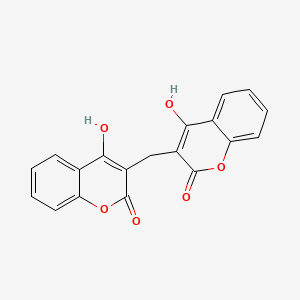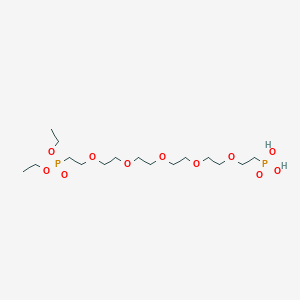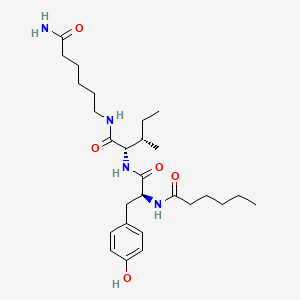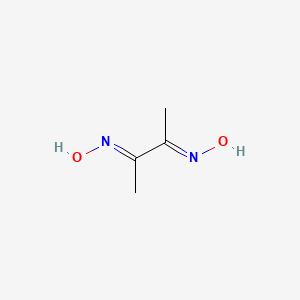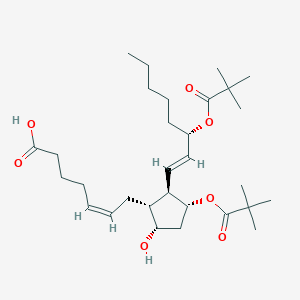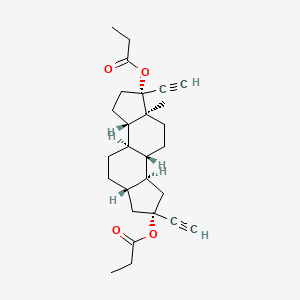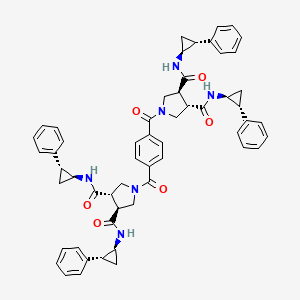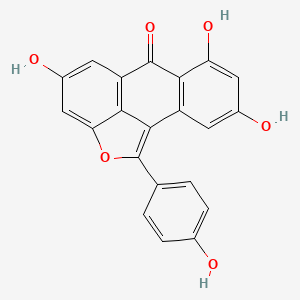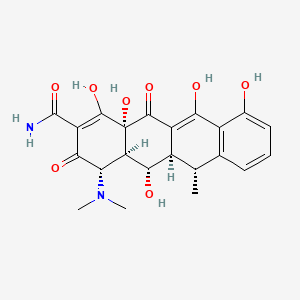
多西环素
描述
多西环素是一种广谱抗生素,属于四环素类。它用于治疗各种细菌感染,包括细菌性肺炎、痤疮、衣原体感染、莱姆病、霍乱、斑疹伤寒和梅毒。 它也用于预防疟疾 . 多西环素于 1957 年首次获得专利,并于 1967 年投入商业使用 . 它作为一种通用药物上市,并列入世界卫生组织基本药物清单 .
作用机制
多西环素通过抑制细菌蛋白质合成发挥作用。 它可逆地结合到 30S 核糖体亚基,阻止氨酰-tRNA 与细菌核糖体结合 . 这种蛋白质合成的抑制是抑菌性的,这意味着它可以阻止细菌的生长和繁殖。 多西环素还会靶向疟原虫的质体,干扰其功能 .
科学研究应用
生化分析
Biochemical Properties
Doxycycline interacts with various enzymes, proteins, and other biomolecules. It is a highly lipophilic drug, which allows it to cross multiple membranes of target molecules . This property facilitates its favorable intracellular penetration, exhibiting bacteriostatic activity against a wide range of bacteria .
Cellular Effects
Doxycycline has been found to alter the metabolism and proliferation of human cell lines . It changes gene expression patterns and shifts metabolism towards a more glycolytic phenotype, evidenced by increased lactate secretion and reduced oxygen consumption . These concentrations of doxycycline are also sufficient to slow proliferation .
Molecular Mechanism
Doxycycline exerts its effects at the molecular level primarily by inhibiting protein synthesis . It does this by interacting with the 30S ribosomal subunits, thereby slowing or killing bacteria . It also kills malaria by targeting a plastid organelle, the apicoplast .
Temporal Effects in Laboratory Settings
In laboratory settings, commonly used concentrations of doxycycline have been observed to change gene expression patterns over time . This results in a shift in metabolism towards a more glycolytic phenotype, evidenced by increased lactate secretion and reduced oxygen consumption . These concentrations are also sufficient to slow cell proliferation .
Dosage Effects in Animal Models
The effects of doxycycline vary with different dosages in animal models . For instance, in donkeys, it has been observed that the concentration of doxycycline reached in all fluids and tissues analyzed would unlikely result in therapeutic concentration against common equine pathogens .
Metabolic Pathways
Doxycycline is involved in various metabolic pathways. It has been reported to shift metabolism towards a more glycolytic phenotype in human cell lines . This is evidenced by increased lactate secretion and reduced oxygen consumption .
Transport and Distribution
Doxycycline is more or less completely absorbed and is 3–5 times more lipophilic than drugs in group 1 . This may improve their tissue distribution but convincing data is absent . It is available in oral and intravenous formulations .
Subcellular Localization
As a highly lipophilic drug, doxycycline is known to cross multiple membranes of target molecules, which may influence its subcellular localization .
准备方法
多西环素是通过化学方法从土霉素衍生而来。其制备过程包括以下几个步骤:
氯化和脱水: 土霉素经氯化和脱水形成 11α-氯-6-亚甲基土霉素对甲苯磺酸盐。
氢化: 然后将该中间体进行一步或两步氢化反应,生成多西环素对甲苯磺酸盐。
精制: 最后,对产品进行精制,形成多西环素盐酸盐.
化学反应分析
多西环素会发生各种化学反应,包括:
氧化: 高级氧化工艺,例如光解、过氧化、光过氧化和臭氧化,在降解多西环素方面非常有效.
光降解: 多西环素对光敏感,会发生光降解,可以通过形成环糊精复合物来减轻.
水解: 该化合物在特定条件下也会发生水解。
这些反应中常用的试剂包括过氧化氢用于过氧化和臭氧用于臭氧化。 这些反应产生的主要产物通常是降解形式的多西环素,其抗菌活性降低 .
相似化合物的比较
多西环素经常与其他四环素类药物进行比较,例如四环素、土霉素、金霉素、地美环素、利美环素、甲环素和米诺环素 . 与这些化合物相比,多西环素具有几个独特的特征:
吸收: 多西环素口服吸收比旧的四环素更可靠.
亲脂性: 它更亲脂,使其更容易通过细菌脂质双层.
半衰期: 多西环素的血清半衰期更长,可以减少给药频率.
类似的化合物包括:
米诺环素: 另一种第二代四环素,具有类似的吸收和亲脂性特性.
四环素: 一种较旧的四环素,吸收性较差,半衰期较短.
替加环素: 一种甘氨酰环素,具有改善的抗菌谱,但只能以注射剂形式获得.
属性
IUPAC Name |
(4S,4aR,5S,5aR,6R,12aR)-4-(dimethylamino)-1,5,10,11,12a-pentahydroxy-6-methyl-3,12-dioxo-4a,5,5a,6-tetrahydro-4H-tetracene-2-carboxamide | |
|---|---|---|
| Source | PubChem | |
| URL | https://pubchem.ncbi.nlm.nih.gov | |
| Description | Data deposited in or computed by PubChem | |
InChI |
InChI=1S/C22H24N2O8/c1-7-8-5-4-6-9(25)11(8)16(26)12-10(7)17(27)14-15(24(2)3)18(28)13(21(23)31)20(30)22(14,32)19(12)29/h4-7,10,14-15,17,25-27,30,32H,1-3H3,(H2,23,31)/t7-,10+,14+,15-,17-,22-/m0/s1 | |
| Source | PubChem | |
| URL | https://pubchem.ncbi.nlm.nih.gov | |
| Description | Data deposited in or computed by PubChem | |
InChI Key |
SGKRLCUYIXIAHR-AKNGSSGZSA-N | |
| Source | PubChem | |
| URL | https://pubchem.ncbi.nlm.nih.gov | |
| Description | Data deposited in or computed by PubChem | |
Canonical SMILES |
CC1C2C(C3C(C(=O)C(=C(C3(C(=O)C2=C(C4=C1C=CC=C4O)O)O)O)C(=O)N)N(C)C)O | |
| Source | PubChem | |
| URL | https://pubchem.ncbi.nlm.nih.gov | |
| Description | Data deposited in or computed by PubChem | |
Isomeric SMILES |
C[C@@H]1[C@H]2[C@@H]([C@H]3[C@@H](C(=O)C(=C([C@]3(C(=O)C2=C(C4=C1C=CC=C4O)O)O)O)C(=O)N)N(C)C)O | |
| Source | PubChem | |
| URL | https://pubchem.ncbi.nlm.nih.gov | |
| Description | Data deposited in or computed by PubChem | |
Molecular Formula |
C22H24N2O8 | |
| Source | PubChem | |
| URL | https://pubchem.ncbi.nlm.nih.gov | |
| Description | Data deposited in or computed by PubChem | |
Related CAS |
17086-28-1 (mono-hydrate), 41411-66-9 (6-epimer, mono-hydrochloride), 69935-17-7 (mono-hydrochloride, di-hydrate), 94088-85-4 (calcium salt (1:2)) | |
| Record name | Doxycycline [USAN:INN:BAN] | |
| Source | ChemIDplus | |
| URL | https://pubchem.ncbi.nlm.nih.gov/substance/?source=chemidplus&sourceid=0000564250 | |
| Description | ChemIDplus is a free, web search system that provides access to the structure and nomenclature authority files used for the identification of chemical substances cited in National Library of Medicine (NLM) databases, including the TOXNET system. | |
DSSTOX Substance ID |
DTXSID0037653, DTXSID80992212 | |
| Record name | Doxycycline | |
| Source | EPA DSSTox | |
| URL | https://comptox.epa.gov/dashboard/DTXSID0037653 | |
| Description | DSSTox provides a high quality public chemistry resource for supporting improved predictive toxicology. | |
| Record name | 4-(Dimethylamino)-1,5,10,11,12a-pentahydroxy-6-methyl-3,12-dioxo-3,4,4a,5,5a,6,12,12a-octahydrotetracene-2-carboximidic acid | |
| Source | EPA DSSTox | |
| URL | https://comptox.epa.gov/dashboard/DTXSID80992212 | |
| Description | DSSTox provides a high quality public chemistry resource for supporting improved predictive toxicology. | |
Molecular Weight |
444.4 g/mol | |
| Source | PubChem | |
| URL | https://pubchem.ncbi.nlm.nih.gov | |
| Description | Data deposited in or computed by PubChem | |
Solubility |
SOL IN WATER /DOXYCYCLINE HYDROCHLORIDE/, VERY SLIGHTLY SOL IN WATER; SPARINGLY SOL IN ALC; FREELY SOL IN DIL ACID & ALKALI HYDROXIDE SOLN; PRACTICALLY INSOL IN CHLOROFORM & ETHER. | |
| Record name | Doxycycline | |
| Source | DrugBank | |
| URL | https://www.drugbank.ca/drugs/DB00254 | |
| Description | The DrugBank database is a unique bioinformatics and cheminformatics resource that combines detailed drug (i.e. chemical, pharmacological and pharmaceutical) data with comprehensive drug target (i.e. sequence, structure, and pathway) information. | |
| Explanation | Creative Common's Attribution-NonCommercial 4.0 International License (http://creativecommons.org/licenses/by-nc/4.0/legalcode) | |
| Record name | DOXYCYCLINE | |
| Source | Hazardous Substances Data Bank (HSDB) | |
| URL | https://pubchem.ncbi.nlm.nih.gov/source/hsdb/3071 | |
| Description | The Hazardous Substances Data Bank (HSDB) is a toxicology database that focuses on the toxicology of potentially hazardous chemicals. It provides information on human exposure, industrial hygiene, emergency handling procedures, environmental fate, regulatory requirements, nanomaterials, and related areas. The information in HSDB has been assessed by a Scientific Review Panel. | |
Mechanism of Action |
Protein synthesis is essential for survival and functioning of cells, including bacteria. Doxycycline inhibits bacterial protein synthesis by allosterically binding to the 30S prokaryotic ribosomal subunit. The drug blocks the association charged aminoacyl-tRNA (aa-tRNA) with the ribosomal A site, which is the acceptor site on the mRNA-ribosome complex. Doxycycline ultimately impedes the elongation phase of protein synthesis and halts the production of essential proteins for bacterial survival and functioning. Doxycycline mediates anti-inflammatory actions by preventing calcium-dependent microtubular assembly and lymphocytic proliferation, thereby inhibiting leukocyte movement during inflammation. It also inhibits nitric oxide synthase, which is an enzyme that produces nitric oxide, an inflammatory signaling molecule., TETRACYCLINES INHIBIT BACTERIAL PROTEIN SYNTHESIS. ... ONCE TETRACYCLINES GAIN ACCESS TO THE BACTERIAL CELL, THEY BIND PRINCIPALLY TO 30 S SUBUNITS OF BACTERIAL RIBOSOMES. THEY APPEAR TO PREVENT ACCESS OF AMINOACYL T-RNA TO M-RNA-RIBOSOME COMPLEX. ... ONLY SMALL PORTION OF DRUG IS IRREVERSIBLY BOUND, & INHIBITORY EFFECTS OF THE TETRACYCLINESARE REVERSIBLE WHEN THE DRUG IS REMOVED. /TETRACYCLINES/ | |
| Record name | Doxycycline | |
| Source | DrugBank | |
| URL | https://www.drugbank.ca/drugs/DB00254 | |
| Description | The DrugBank database is a unique bioinformatics and cheminformatics resource that combines detailed drug (i.e. chemical, pharmacological and pharmaceutical) data with comprehensive drug target (i.e. sequence, structure, and pathway) information. | |
| Explanation | Creative Common's Attribution-NonCommercial 4.0 International License (http://creativecommons.org/licenses/by-nc/4.0/legalcode) | |
| Record name | DOXYCYCLINE | |
| Source | Hazardous Substances Data Bank (HSDB) | |
| URL | https://pubchem.ncbi.nlm.nih.gov/source/hsdb/3071 | |
| Description | The Hazardous Substances Data Bank (HSDB) is a toxicology database that focuses on the toxicology of potentially hazardous chemicals. It provides information on human exposure, industrial hygiene, emergency handling procedures, environmental fate, regulatory requirements, nanomaterials, and related areas. The information in HSDB has been assessed by a Scientific Review Panel. | |
Color/Form |
YELLOW, CRYSTALLINE POWDER | |
CAS No. |
564-25-0, 7164-70-7, 24390-14-5 | |
| Record name | Doxycycline [USAN:INN:BAN] | |
| Source | ChemIDplus | |
| URL | https://pubchem.ncbi.nlm.nih.gov/substance/?source=chemidplus&sourceid=0000564250 | |
| Description | ChemIDplus is a free, web search system that provides access to the structure and nomenclature authority files used for the identification of chemical substances cited in National Library of Medicine (NLM) databases, including the TOXNET system. | |
| Record name | Doxycycline | |
| Source | DrugBank | |
| URL | https://www.drugbank.ca/drugs/DB00254 | |
| Description | The DrugBank database is a unique bioinformatics and cheminformatics resource that combines detailed drug (i.e. chemical, pharmacological and pharmaceutical) data with comprehensive drug target (i.e. sequence, structure, and pathway) information. | |
| Explanation | Creative Common's Attribution-NonCommercial 4.0 International License (http://creativecommons.org/licenses/by-nc/4.0/legalcode) | |
| Record name | Doxycycline | |
| Source | EPA DSSTox | |
| URL | https://comptox.epa.gov/dashboard/DTXSID0037653 | |
| Description | DSSTox provides a high quality public chemistry resource for supporting improved predictive toxicology. | |
| Record name | 4-(Dimethylamino)-1,5,10,11,12a-pentahydroxy-6-methyl-3,12-dioxo-3,4,4a,5,5a,6,12,12a-octahydrotetracene-2-carboximidic acid | |
| Source | EPA DSSTox | |
| URL | https://comptox.epa.gov/dashboard/DTXSID80992212 | |
| Description | DSSTox provides a high quality public chemistry resource for supporting improved predictive toxicology. | |
| Record name | Doxycycline | |
| Source | European Chemicals Agency (ECHA) | |
| URL | https://echa.europa.eu/substance-information/-/substanceinfo/100.008.429 | |
| Description | The European Chemicals Agency (ECHA) is an agency of the European Union which is the driving force among regulatory authorities in implementing the EU's groundbreaking chemicals legislation for the benefit of human health and the environment as well as for innovation and competitiveness. | |
| Explanation | Use of the information, documents and data from the ECHA website is subject to the terms and conditions of this Legal Notice, and subject to other binding limitations provided for under applicable law, the information, documents and data made available on the ECHA website may be reproduced, distributed and/or used, totally or in part, for non-commercial purposes provided that ECHA is acknowledged as the source: "Source: European Chemicals Agency, http://echa.europa.eu/". Such acknowledgement must be included in each copy of the material. ECHA permits and encourages organisations and individuals to create links to the ECHA website under the following cumulative conditions: Links can only be made to webpages that provide a link to the Legal Notice page. | |
| Record name | 2-Naphthacenecarboxamide, 4-(dimethylamino)-1,4,4a,5,5a,6,11,12a-octahydro-3,5,10,12,12a-pentahydroxy-6-methyl-1,11-dioxo-, hydrochloride, (4S,4aR,5S,5aR,6R,12aS)-, compd. with ethanol, hydrate (2:2:1:1) | |
| Source | European Chemicals Agency (ECHA) | |
| URL | https://echa.europa.eu/substance-information/-/substanceinfo/100.106.555 | |
| Description | The European Chemicals Agency (ECHA) is an agency of the European Union which is the driving force among regulatory authorities in implementing the EU's groundbreaking chemicals legislation for the benefit of human health and the environment as well as for innovation and competitiveness. | |
| Explanation | Use of the information, documents and data from the ECHA website is subject to the terms and conditions of this Legal Notice, and subject to other binding limitations provided for under applicable law, the information, documents and data made available on the ECHA website may be reproduced, distributed and/or used, totally or in part, for non-commercial purposes provided that ECHA is acknowledged as the source: "Source: European Chemicals Agency, http://echa.europa.eu/". Such acknowledgement must be included in each copy of the material. ECHA permits and encourages organisations and individuals to create links to the ECHA website under the following cumulative conditions: Links can only be made to webpages that provide a link to the Legal Notice page. | |
| Record name | Doxycycline Hyclate | |
| Source | European Chemicals Agency (ECHA) | |
| URL | https://echa.europa.eu/information-on-chemicals | |
| Description | The European Chemicals Agency (ECHA) is an agency of the European Union which is the driving force among regulatory authorities in implementing the EU's groundbreaking chemicals legislation for the benefit of human health and the environment as well as for innovation and competitiveness. | |
| Explanation | Use of the information, documents and data from the ECHA website is subject to the terms and conditions of this Legal Notice, and subject to other binding limitations provided for under applicable law, the information, documents and data made available on the ECHA website may be reproduced, distributed and/or used, totally or in part, for non-commercial purposes provided that ECHA is acknowledged as the source: "Source: European Chemicals Agency, http://echa.europa.eu/". Such acknowledgement must be included in each copy of the material. ECHA permits and encourages organisations and individuals to create links to the ECHA website under the following cumulative conditions: Links can only be made to webpages that provide a link to the Legal Notice page. | |
| Record name | DOXYCYCLINE ANHYDROUS | |
| Source | FDA Global Substance Registration System (GSRS) | |
| URL | https://gsrs.ncats.nih.gov/ginas/app/beta/substances/334895S862 | |
| Description | The FDA Global Substance Registration System (GSRS) enables the efficient and accurate exchange of information on what substances are in regulated products. Instead of relying on names, which vary across regulatory domains, countries, and regions, the GSRS knowledge base makes it possible for substances to be defined by standardized, scientific descriptions. | |
| Explanation | Unless otherwise noted, the contents of the FDA website (www.fda.gov), both text and graphics, are not copyrighted. They are in the public domain and may be republished, reprinted and otherwise used freely by anyone without the need to obtain permission from FDA. Credit to the U.S. Food and Drug Administration as the source is appreciated but not required. | |
| Record name | DOXYCYCLINE | |
| Source | Hazardous Substances Data Bank (HSDB) | |
| URL | https://pubchem.ncbi.nlm.nih.gov/source/hsdb/3071 | |
| Description | The Hazardous Substances Data Bank (HSDB) is a toxicology database that focuses on the toxicology of potentially hazardous chemicals. It provides information on human exposure, industrial hygiene, emergency handling procedures, environmental fate, regulatory requirements, nanomaterials, and related areas. The information in HSDB has been assessed by a Scientific Review Panel. | |
Q1: What is doxycycline's primary mechanism of action?
A1: Doxycycline is a tetracycline antibiotic that inhibits bacterial protein synthesis by binding to the 30S ribosomal subunit, effectively blocking the attachment of aminoacyl-tRNA to the ribosomal acceptor (A) site. []
Q2: How does doxycycline affect Brugia malayi infections?
A2: Doxycycline targets the endosymbiotic bacteria Wolbachia, which is essential for Brugia malayi survival and reproduction. By reducing Wolbachia loads, doxycycline effectively decreases microfilaremia and reduces adverse reactions associated with standard antifilarial treatment. []
Q3: Does doxycycline impact matrix metalloproteinases (MMPs)?
A3: Yes, doxycycline has been shown to inhibit MMP activity, particularly MMP-2 and MMP-9. This inhibition is attributed to its chelating properties, where it binds to metal ions essential for MMP catalytic activity. [, ]
Q4: How does doxycycline influence epithelial-mesenchymal transition (EMT)?
A4: Doxycycline has been shown to inhibit TGF-beta1-induced EMT and cell migration in respiratory epithelial cells by suppressing the activation of Smad2/3 and p38 signaling pathways. []
Q5: What is the molecular formula and weight of doxycycline?
A5: Doxycycline hyclate, the commonly used form, has a molecular formula of C22H24N2O8 • HCl • 1/2 C2H6O • 1/2 H2O and a molecular weight of 512.94 g/mol.
Q6: Is there any spectroscopic data available for doxycycline?
A6: While the provided research papers don't detail specific spectroscopic data, FTIR analysis has been used to evaluate drug-drug interactions between doxycycline and monocaprin in a hydrogel formulation. []
Q7: How stable is doxycycline in different formulations?
A7: Doxycycline stability can be affected by various factors, including formulation components and storage conditions. For instance, the addition of monocaprin to doxycycline in situ hydrogel negatively impacted doxycycline stability in a concentration-dependent manner. []
Q8: Can you provide an example of doxycycline's compatibility in a specific application?
A8: Doxycycline has been successfully incorporated into biodegradable poly(D,L-lactide-co-glycolide) (PLGA) nanofibers for targeted drug delivery in tendon rupture repair. []
Q9: How do structural modifications affect doxycycline's activity?
A9: While the provided papers do not directly investigate SAR, research on optimized tetracyclines with modifications at the 7-position shows enhanced in vitro and in vivo antimalarial activity compared to doxycycline. []
Q10: What strategies are employed to enhance doxycycline's stability and bioavailability?
A10: Various formulation strategies, such as encapsulation in nanofibers [] and incorporation into in situ hydrogels [], are being explored to improve doxycycline's stability, solubility, and controlled release for targeted delivery and enhanced therapeutic outcomes.
Q11: How is doxycycline absorbed and distributed in the body?
A11: Doxycycline is well-absorbed orally and achieves therapeutic concentrations in serum and tissues, including lung and synovial fluid. Its lipid solubility allows for good tissue penetration. [, ]
Q12: What factors can influence doxycycline's pharmacokinetics?
A12: Co-administration of certain drugs can alter doxycycline's PK profile. For example, oral antacid administration was found to enhance the clearance of intravenous doxycycline, shortening its half-life and increasing total body clearance. []
Q13: Does doxycycline cross the blood-brain barrier?
A13: Yes, doxycycline can penetrate the blood-brain barrier and achieve therapeutic concentrations in the cerebrospinal fluid (CSF), making it effective for treating neuroborreliosis. []
Q14: How is doxycycline eliminated from the body?
A14: Doxycycline is primarily eliminated through both renal and non-renal pathways. It is excreted in urine and feces. []
Q15: Can doxycycline levels be measured in biological samples?
A15: Yes, various analytical methods like high-performance liquid chromatography (HPLC) and liquid chromatography-mass spectrometry (LC-MS) are used to quantify doxycycline concentrations in biological samples such as serum, plasma, CSF, and tears. [, , ]
Q16: What cell lines have been used to study doxycycline's effects?
A16: Researchers have employed various cell lines, including A549 lung cells [], primary human corneal epithelial cells [], and equine synoviocytes [], to investigate doxycycline's impact on EMT, MMP expression, and other cellular processes.
Q17: Are there animal models used in doxycycline research?
A17: Yes, doxycycline's efficacy and safety have been evaluated in animal models, including rat models for tendon rupture repair [], murine models for Mycobacterium avium infection [], and canine models for monocytic ehrlichiosis. []
Q18: Has doxycycline been tested in clinical trials?
A18: Yes, several clinical trials have investigated the efficacy and safety of doxycycline for various conditions. For example, a randomized controlled trial assessed the effect of doxycycline on MMP expression in atherosclerotic plaques in patients undergoing carotid endarterectomy. []
Q19: Are there known mechanisms of resistance to doxycycline?
A19: Yes, bacterial resistance to doxycycline can occur through mechanisms such as efflux pump overexpression, ribosomal protection proteins, and enzymatic inactivation. []
Q20: Is there cross-resistance between doxycycline and other antibiotics?
A20: Cross-resistance can occur between doxycycline and other tetracycline-class antibiotics due to shared mechanisms of resistance. []
Q21: What drug delivery strategies have been explored for doxycycline?
A21: Researchers are investigating novel drug delivery systems for doxycycline, including electrospun nanofibrous membranes for localized and sustained release in tendon rupture repair. []
Q22: What analytical methods are used to quantify doxycycline?
A22: Common analytical techniques include HPLC, LC-MS, and microbial assays. These methods are employed to measure doxycycline concentrations in various biological samples and assess its pharmacokinetics, residues, and stability in different formulations. [, , ]
体外研究产品的免责声明和信息
请注意,BenchChem 上展示的所有文章和产品信息仅供信息参考。 BenchChem 上可购买的产品专为体外研究设计,这些研究在生物体外进行。体外研究,源自拉丁语 "in glass",涉及在受控实验室环境中使用细胞或组织进行的实验。重要的是要注意,这些产品没有被归类为药物或药品,他们没有得到 FDA 的批准,用于预防、治疗或治愈任何医疗状况、疾病或疾病。我们必须强调,将这些产品以任何形式引入人类或动物的身体都是法律严格禁止的。遵守这些指南对确保研究和实验的法律和道德标准的符合性至关重要。



![Methyl 1,5-dibromo-11,17-dimethoxy-18-[(3,4,5-trimethoxybenzoyl)oxy]yohimban-16-carboxylate](/img/structure/B607107.png)
